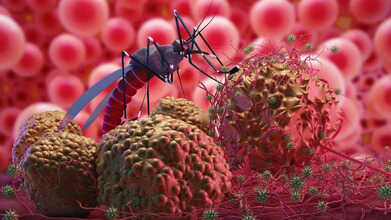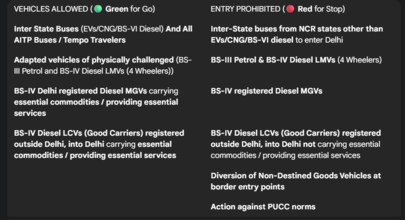- Health Conditions A-Z
- Health & Wellness
- Nutrition
- Fitness
- Health News
- Ayurveda
- Videos
- Medicine A-Z
- Parenting
First New Malaria Drug In Years Shows Strong Trial Results, Could Help Fight Rising Resistance

Credits: Canva
A new and potentially life-saving step in the fight against malaria has surfaced as Novartis announced a promising drug combination that could prove crucial in regions where existing treatments are becoming less effective. Malaria continues to claim nearly 600,000 lives every year, though that number was once around 2 million about 25 years ago. The rise in deaths has been linked to the parasite’s growing resistance to long-used drugs, said George Jagoe, Executive Vice President for Access and Product Management at Medicines for Malaria Venture (MMV). Thankfully, a new malaria medicine now shows real promise as an effective tool against resistant strains.
New Malaria Treatments Show Promise As Drug Resistance Grows
On Wednesday, researchers revealed two new ways to fight the growing problem of malaria resistance, one of which involves a fresh class of drugs. Swiss pharmaceutical company Novartis shared results of what it called a next-generation therapy. The study, conducted in 12 African countries, showed that its experimental drug worked effectively against the malaria parasite and also appeared to prevent transmission.
What Is GanLum?
The new drug, known as ganaplacide/lumefantrine or GanLum, was jointly developed by Novartis and Medicines for Malaria Venture, a non-profit organisation. According to Reuters, it was more than 97% successful in treating malaria during a phase III trial involving 1,688 adults and children across 34 sites in 12 African countries, Novartis reported. Malaria still kills more than 600,000 people each year, most of them children under five in sub-Saharan Africa.
GanLum is given as a packet of fine powder once daily for three days. However, getting patients to complete multi-day treatment remains a challenge. Many people stop after the first or second dose, once they begin to feel better. Experts estimate that about one-third of malaria patients fail to finish the full course, which can increase drug resistance and worsen otherwise curable infections.
In a separate study, researchers testing a one-time treatment found that a single dose made up of four commonly available malaria medicines worked well in curing the infection. Both studies were presented on Wednesday at the American Society of Tropical Medicine and Hygiene conference in Toronto.
Parasite Has Repeatedly Developed Drug Resistance
Malaria is caused by a parasite transmitted through mosquito bites. Infected individuals experience fever, chills, and flu-like symptoms that, if untreated, can become severe and even fatal. The disease primarily affects tropical and subtropical regions, with the highest death toll seen among children in sub-Saharan Africa.
The medical community’s fight against malaria has seen highs and lows as new treatments appear, only for the parasite to eventually develop resistance.
At the turn of this century, resistance to the once-effective chloroquine became widespread, and malaria deaths climbed to over 1.8 million annually. The introduction of a new group of drugs known as artemisinins helped reduce global malaria deaths dramatically.
As per NHS, today, artemisinin-based therapies remain the standard treatment. Yet, early signs of partial resistance have begun to appear, and due to several factors, global malaria death rates have either stagnated or started to rise in certain regions.
Experimental Treatment Shows Promise
GanLum, developed by Novartis, combines a new compound, ganaplacide, with an existing long-acting medication, lumefantrine. In a trial involving around 1,700 adults and children across 12 African nations, GanLum achieved a cure rate exceeding 97%, slightly higher than that of standard artemisinin-based therapies. It also proved highly effective against mutated malaria parasites that show partial resistance, according to Novartis officials.
Reported side effects included fever and anemia, similar to those seen with other antimalarial drugs. There was also a higher rate of vomiting immediately after administration, which experts suggest may be related to the drug’s taste. The company has said it is exploring ways to make it more palatable, such as by adding flavouring or sweeteners, Reuters reported.
Amid Delhi's Toxic Smog And Severe AQI, Authorities Implement GRAP-3 Measures; What Does It Mean For People?

Credits: PTI
As Delhi's air quality continues to deteriorate, and reached emergency levels on Tuesday, as per the official data, it has been declared to be the worst in nearly 11 months. As a result, Graded Response Action Plan (GRAP) Stage-3 has been implemented in Delhi.
As of Tuesday, the city's average AQI as per the official data, stood at 428, this is worst since December 19 of last year, when the index read 451. This is a sharp rise from 362 AQI on Monday. Visibility too dropped to 600 metres at Safdarjung and 700 metres at Palam at 6.30am. The Central Pollution Control Board (CPCB) data continued to record 'severe' air quality levels across Delhi-NCR even on Wednesday morning.
You May Like To Read: Delhi Air Pollution: Think Pollution Only Hurts Your Lungs? Doctors Say It Can Cause Strokes Too
What Does GRAP 3 Mean For People?
GRAP is a 9-point action plan that is being implemented to bring down pollution. The restrictions are imposed in Delhi, and comprises a list of the type of vehicles, which are allowed in the national capital. This means, if you do not live in Delhi, and are travelling via Delhi, you will also have to comply with the rules. Failure to do so may invite penalty.

As per the Commission for Air Quality Management (CAQM)'s statement: "Considering the ongoing trend in air quality and to prevent further decline, the sub-committee has decided to implement all measures under Stage III of GRAP – ‘Severe’ air quality (Delhi AQI between 401 and 450) – with immediate effect across the NCR."
Which Zones Are Affected?
The enforcement zones include Delhi and NCR too, including Gurugram, Faridabad, Ghaziabad, Gautam Buddha Nagar.
Are There Any Other Restrictions?

The restriction is not only on the vehicles, but also on dust-generating construction and demolition activities. The restrictions also include:
- Demolition Work
- Excavation or Earthwork, which includes laying sewer, water, drainage, or electrical lines
- Brick or masonry work
- Major welding and gas-cutting operations
- Painting, cementing, plastering, or coating work
- Tile cutting, grinding, and fixing
- Waterproofing and road repair or construction work
- Loading, unloading, or transfer of dust-generating materials
- Movement of vehicles carrying construction materials on unpaved roads
- Transportation of demolition waste
Read More: 1 in 7 Deaths In Delhi In 2023 Were Caused By Air Pollution, Revealed Study
The Delhi Government has also announced that schools up to Class V would be conducted in hybrid mode. Apart from this, all stone crushers and mining operations across NCR has been ordered to shut down.
What Are The GRAP Stages?
GRAP operates on a tiered system, with different stages corresponding to varying levels of AQI. The goal is to implement specific measures at each stage to curb pollution and reduce public health risks. The different stages of GRAP are:
- Stage I: It is triggered when the AQI falls in the range of 201-300, which indicates “poor” to “very poor” air quality.
- Stage II: This happens when the AQI reaches between 301 and 400, reflecting “very poor” to “severe” conditions.
- Stage III: This is implemented when the AQI exceeds 400, which is categorized as “severe” air quality. This stage triggers more stringent measures to reduce pollution levels, with a focus on restricting outdoor activities, vehicle use, and industrial operations.
How Does Pollution Impact One's Health?
Chronic pollution exposure aggravates oxidative stress and systemic inflammation. This means, with every breath you take, you inhale a toxic swamp.
As per Pusan National University, long term air pollution exposure actually triggers allergic immune responses in the lungs. Furthermore, a 2022 study published in the International Journal of Environmental Research and Public Health also shows the negative impact on immune system with alarming and harmful air quality.
As per another 2000 study, published by the British Society for Immunology, people living in areas with higher pollution levels show measurably different immune responses than those in cleaner environment.
Air pollution contains toxins like particulate matter, ozone, carbon monoxide, nitrogen dioxide, and sulfur dioxide. It also includes hazardous air pollutants (HAPs), such as lead, mercury, asbestos, benzene, and other volatile organic compounds. When one breathes this toxic and poisonous air the respiratory system bears the initial brunt of it. The pollutants then damage the delicate tissues lining your airways, and disrupts the barrier that normally prevents harmful substances from entering your body. When this first line of defense is compromised, pathogens find it easier to established infections.
World Pneumonia Day 2025: Theme, Origin, Significance

Credits: Canva
Every year on November 12, World Pneumonia Day is observed. This day aims to spread awareness and educate people to combat Pneumonia disease, which is world's biggest infectious killer of adults and children, especially those below five years.
What Is Pneumonia?
It is an inflammatory respiratory disorder caused due to bacteria, viruses or fungal infections which impair the air sacs of the lungs, called alveoli. It happens due to the accumulation of fluid or pus in the air sacs, making breathing difficult. It is a contagious disease and could be fatal for the person with weaker immunity.
World Pneumonia Day 2025 Theme
This year, the theme for World Pneumonia Day 2025 is 'Child Survival'. This theme recognizes pneumonia as the leading infectious cause of death in children. Dr Raja Dhar, Director and HOD Pulmonology at CMRI Kolkata says, "Pneumonia continues to be a silent killer that claims over 2.5 million lives every year worldwide — with more than half a million of these deaths occurring in children under the age of five."
However, he also notes that this disease also poses a grave threat to older adults.
The theme draws attention to the heartbreaking truth that pneumonia continues to claim the lives of thousands of young children each year—even though it’s both preventable and treatable. It calls on families, communities, and leaders to unite in ensuring every child has access to good nutrition, clean air, vital vaccines, and timely medical care. The message is clear and deeply human: no child should die from a disease we can prevent.
History of World Pneumonia Day
World Pneumonia Day was first observed on November 12 2009, under the 'Stop Pneumonia' initiatives by the Global Coalition Against Child Pneumonia. This was a coalition of various institutions all together to fight the child mortality due to the respiratory infection.
Importance of Pneumonia Day
One of the most important significance of Pneumonia day is to spread awareness of the condition, especially early recognition, so it could be treated timely. Dr Dhar points out that early recognition and timely treatment could save lives.
"Prevention remains our strongest weapon. Regular hand hygiene, avoiding smoking, ensuring good nutrition, and staying up to date with pneumonia and influenza vaccinations—especially for children, older adults, and those with chronic illnesses—can drastically reduce risk," says Dr Dhar.
As the doctor suggests that this day helps us remember that protecting the lungs is equivalent to protecting life. "Seek medical help early for any signs of lung infection, and take proactive steps to safeguard your loved ones, especially the very young and the elderly, from the dangers of pneumonia," says the doctor.
What Are The Common Symptoms Of Pneumonia?
- Persistent cough (with phlegm or mucus)
- High fever and chills
- Chest pain while breathing or coughing
- Shortness of breath
- Fatigue and weakness
How Can You Prevent Pneumonia?
The best ways to prevent pneumonia are:
- Vaccination: get vaccination against flu, pneumococcal infections, and COVID-19
- Good Hygiene: wash hands regularly. The World Health Organization (WHO) recommends washing hands frequently to prevent the spread of germs, and to apply enough soap to cover all hand surface.
- Healthy Lifestyle: maintain a balanced diet, exercise regularly, and get adequate rest
- Avoid smoking
- Eat healthy
Sally Kirkland Dies Days After Entering Hospice Care

Credits: Instagram
Sally Kirkland, 84, dies days after entering hospice. The Oscar nominee actor had entered the hospice care in Palm Springs and the news was confirmed by her rep Michael Greene.
She had endured "a challenging few months", as confirmed by her organizer, and a post from November 7, from her account read: "Thank you for all your love and support. Sally is grateful for your kindness and love. Sally is on hospice now and is resting comfortably. Please hold and send the light for Sally." This was in response to her GoFundMe page, which she had started after her medical bills costed her over what her insurance could cover.
A Long Battle Of Health Crisis
On October 2, an update read: "Hi: Sally sends her love to everyone. It has been a challenging few months for Sally as her health continues to struggle. She had a fall in the shower, when she was left unattended, injuring her ribs and foot, along with cuts and bruises. Sally is now receiving 24/7 care in a specialized facility that is providing wonderful safety and care. We are continuing to raise money to cover the gaps between income and care costs. Thank you for all the love, support, and care for Sally."
Sally's fundraiser was created in November 2024, after Sally "fractured her four bones in neck, right wrist, and her left hip" and while she was recovering, she had developed "two separate life-threatening infections". Her medical bills would mount more than her insurance could cover.
She also created a video shortly after her GoFundMe account was made where she thanked everyone who donated. "Everyone, I just wanted to thank you for sending me your love and your light and helping me get through this, day by day, helping me with my GoFundMe page. It really touches my heart. [I] really feel your love."
The Impact She Left
After the news of her demise, fans have shared tributes online. One user wrote: Devastated to hear of Sally Kirkland's passing. She was an indelible character actor and red carpet icon who was never anything short of memorable. Her awards season campaign for Anna, a powerhouse performance all should see, will always be the greatest.”
“A fantastic, underrated actress. She'll be deeply missed,” wrote another.
She earned an Oscar nomination for her titular character in Yurek Bogayeviczs's Anna (1987).
What Is A Hospice?
Hospice is a specialized care focused on the comfort and quality of life for people with serious illnesses near the end of life. This happens typically when a cure is not possible. It provides physical, emotional, and spiritual support for the patient, as well as for their family. The hospice also aims to manage pain and symptoms, rather than focusing on life-prolonging treatments. This care can be provided at home, in a hospice center, a hospital, or a nursing home. One of the key reasons why patients who have a degenerative condition choose hospice is because of the patient-centric care that it provides.
© 2024 Bennett, Coleman & Company Limited

